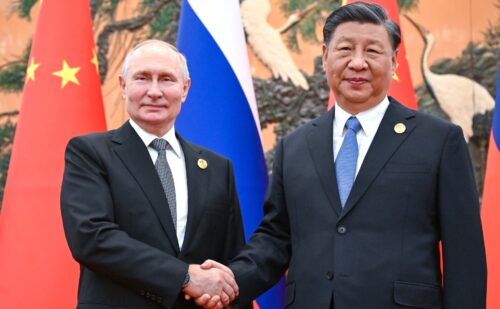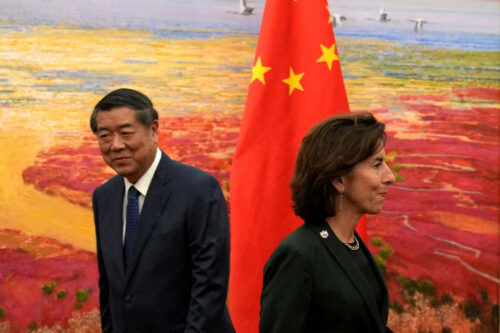China fires back in trade war with Trump, but global face-off in tech is just getting started

China has done away with its tentative approach to combating U.S. President Donald Trump on trade, and issued a full tit-for-tat retaliation for the steel and aluminum tariffs that went into effect a week and a half ago. As we reported in our email to The China Project Access members on March 23, the Ministry of Commerce had announced a measured response to the American tariffs that had no explicit implementation date, and announced that up to 128 products could be taxed in two phases, after further assessment.
- The implementation date is today, and all 128 products are on the list. No two phases, and no hesitation after the initial comment period. The targets range from dozens of fresh fruits to steel pipes and pork (read the full list on Quartz) — many of the agricultural tariffs seem targeted at Donald Trump’s more rural political base.
- The $3 billion total value of the tariffs, as we noted on March 23, is roughly proportional to the amount of Chinese steel and aluminum that the U.S. imports annually.
- It’s a sign that negotiations are going poorly between the two sides, as they try to prevent escalations in trade tensions.
- It’s also a sign that the $50 billion in more wide-ranging tariffs that the Trump administration is currently drafting will be met with a similarly proportional response, ensuring economic pain on both sides.
Those wide-ranging tariffs are where “trade war” — what the Financial Times has officially called (paywall) the current opening volley of tariffs — could additionally become a “tech war.”
- While items “such as clothing and footwear” were initially included on the reported potential list of Chinese products for the U.S. to target, those reports were met with “strong protests from U.S. business groups,” Reuters reports.
- Targeting technology instead is a strategy with wide bipartisan appeal and support from the business community in the U.S.
- A “series of actions” are being prepared by the Trump Administration “to respond to what it sees as unfair collusion between the Chinese government and Chinese companies to take over the industries of the future and then use that influence to promote China’s political agenda,” the Washington Post reports. The “collusion” that this refers to, trade advisor Peter Navarro specified to Bloomberg last week, is the “Made in China 2025” policy.
- “Why Does Everyone Hate Made in China 2025?” is the title of an excellent blog post from Lorand Laskai at the Council on Foreign Relations, which explains why high-tech companies around the world are so worried about China’s industrial policy. Hint: It has to do with an explicit goal of replacing, rather than competing with, non-Chinese technology firms, and the tactics that China seems willing to use to achieve that end.
- Even Elizabeth Warren, the Democratic U.S. senator from Massachusetts, who is one of Donald Trump’s most prominent rivals, visited Beijing in recent days and declared that she and other policymakers were “starting to look more aggressively at pushing China to open up the markets without demanding a hostage price of access to U.S. technology.”
- Politicians in Washington, in other words, seem dead set on directly countering China’s “Made in China 2025” industrial policy, regardless of any short-term agreement on trade.
More on trade wars, tech wars, and pork:
- Notes on this round of tariffs
New York Times (paywall): China’s “state-run news media has condemned the Trump administration’s protectionist steps and presented China as the innocent defender of open trade. In fact, China imposes relatively high barriers on many imports and on foreign investment in many sectors.”
AFP: “Beijing has so far held fire against major agricultural products such as soybeans or major industries such as aerospace giant Boeing — items that state-run daily Global Times suggests should be targeted.”
US stocks sink on trade concerns; China pork duty hits Tyson / AP
China’s cutting taxes for the industries Trump wants to punish / Bloomberg
U.S. envoy says China retaliation on soybeans would backfire / Bloomberg
China tariffs on U.S. ethanol to cut off imports in short-term / Reuters
China metals group eyeing new counter-measures in U.S. trade row / Reuters - About forced tech transfers and Made in China 2025
Full report from the U.S. Trade Representative, titled “Findings of the investigation into China’s acts, policies, and practices related to technology transfer, intellectual property, and innovation under section 301 of the Trade Act of 1974”
US ‘lacks evidence’ for forced tech transfers claim against China at WTO / SCMP - 5G and telecoms
America is hanging up on China’s telecom industry / Washington Post
Why China and the US are fighting over 5G / TechNode
Trump’s China concern adds pressure in race to be first with 5G / Bloomberg - France looking to join with Germany in push back against Made in China 2025
Macron unveils $1.9 billion technology push to rival U.S., China / Bloomberg






